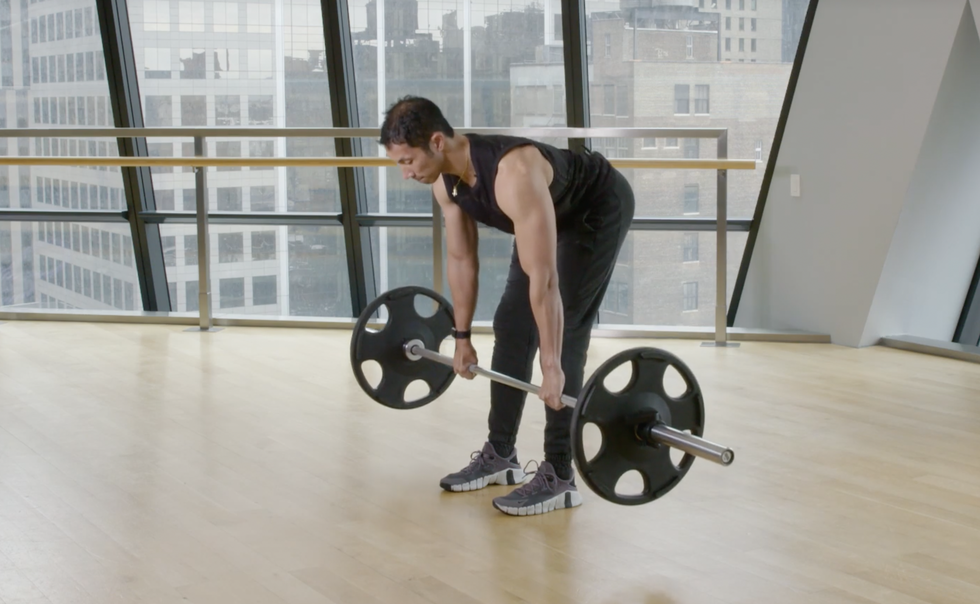WHEN YOU NEED to power up your posterior muscles, there are few more effective exercises than the deadlift. There’s one deadlift variation that may have gotten lost in the weight room shadows, however, that just might be one of your best options for homing in on your hamstrings and building resiliency in your lower back: the stiff-leg deadlift.
The stiff leg deadlift is far from a new exercise, and may not even be the best hamstring exercise in your arsenal, even if Arnold once included them in his routine during his Golden Era bodybuilding reign. Many gym-goers today are either unfamiliar with this move or typically opt for the popular Romanian deadlift instead.
The stiff leg deadlift won’t be a movement you’ll use to bust out a new 1RM, like its standard or sumo-style counterparts, but stiff-leg deadlifts can still be a viable addition to your workout, says Men’s Health fitness director Ebenezer Samuel, C.S.C.S.
“I like to think of it as an emergency hamstring exercise,” Samuel says. “If you are in a situation and you only have barbells or you only have dumbbells, and you don’t have access to any of the other tools that can train your hamstrings, then maybe you’re going to go to the stiff-leg deadlift, that way you can get that hamstring engagement.”
Muscles Worked with Stiff Leg Deadlifts
- Glutes
- Lower back
- Hamstrings
- Calves
- Core
Who Should Perform Stiff Leg Deadlifts?
The stiff leg deadlift doesn’t allow you to work with a ton of weight and offers a more specific goal—targeting the hamstrings—than the conventional variation, so it doesn’t really qualify as a go-to deadlift for everyone’s routine. Samuel thinks of the movement as an “emergency exercise,” to be employed when other hamstring focused movements aren’t an option.
This is a good exercise for people who might struggle to find an exercise that allows them to feel hamstring engagement.
What Is the Difference Between the Stiff Leg Deadlift and Conventional Deadlift?
The stiff leg name is a bit of a misnomer. Your legs won’t be completely locked throughout the movement, so don’t make that a major cue. That said, you will be working from a position where your knees are more straight than during conventional deadlifts.
That’s the primary difference between the two: with stiff leg deadlifts, your goal is to perform the move with as little knee bend as possible. Because you’re working from a “stiffer” position, your hips will be working from a higher position, requiring your torso to become more parallel with the ground.
You’ll see three results from this position:
- Since your knees will be straighter than conventional deadlifts, you’re removing much of the quad engagement out of the exercises. This places more challenge on the posterior chain muscles.
- Your lower back will work as a lever throughout the stiff leg deadlift as push your glutes back. You’ll find yourself in more of a flat “table top” position, which can add a little more lower back stress than other variations. This is a key reason why you’ll need to work with lighter weights—and why you’ll also build a bit of lower back resiliency during the exercise.
- Your hips and knees also become increasingly lengthened, since you’re working your hamstrings from a more lengthened position with the stiff leg deadlift. This puts the hamstrings at a bit of a disadvantage when it comes to straightening up at the top of the deadlift.
How to Do the Stiff Leg Deadlift
The setup for the stiff leg deadlift is similar to what you’ll do for a conventional deadlift.
- Stand in front of the barbell with your feet at shoulder-width apart. The bar should be close to your body, almost touching your shins, with your feet under the bar.
- Push your butt back, then lower your torso to reach down and grab the bar. Your knees can bend, but keep them as straight as you can.
- With your shoulder blades slightly squeezed, and a slight, natural bend in the knees, brace through your abs as you begin to pull the bar from the floor. You don’t need to be as aggressive in the pull as you would with the conventional deadlift (but don’t pull it softly either).
- From here, think of the move as a Romanian deadlift—you’re going to push your butt back as you lower the weight down to the floor, taking two to three seconds on the descent. Pause, then lift the bar back up.
How to Use the Stiff Leg Deadlift in Your Workouts
There are several other hamstring exercises that may work better than stiff leg deadlifts—Samuel mentions leg curls, Nordic curls, and even the conventional deadlift for most people. However, you can use this as an accessory exercise to get the hamstring engagement you might want.
Just make sure that you don’t load up the bar with a ton of weight. Samuel suggests aiming for about half of what you’d use for your standard deadlift load (or even less). Since you’re using lower weights, you can work with high reps and sets. Start at about three to four sets of eight to 10 reps. Make each rep slow and methodical, with a focus on pushing your butt back, bracing your core, and keeping your knees as stiff as possible.
Jeff Tomko is a freelance fitness writer who has written for Muscle and Fitness, Men’s Fitness, and Men’s Health.
Brett Williams, a fitness editor at Men’s Health, is a NASM-CPT certified trainer and former pro football player and tech reporter who splits his workout time between strength and conditioning training, martial arts, and running. You can find his work elsewhere at Mashable, Thrillist, and other outlets.



Comments are closed.